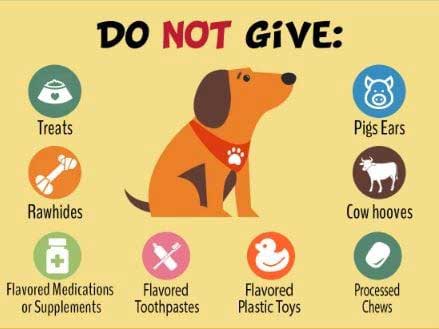Food Allergies in Dogs 101: Part 2 of 2

Hello, again! If you read my last blog post about food allergies in dogs, you know it had a cliffhanger of an ending. If you were on the edge of your seat, you can breathe a sigh of relief! I’m back with the much-anticipated follow-up post where I’ll go into detail about the food trial.
The gold standard method used to diagnose food allergies in dogs is an 8-12 week food trial. If the dog has a food allergy, any gastrointestinal symptoms typically improve within 2-3 weeks and 90% of dogs with skin issues improve within 8 weeks. It requires diligence to get through those 2-3 months. The food trial needs to be done right in order to work. Everyone spending time with the dog needs to be fully committed to the mission.
So, how do we get started? First, we discuss what proteins have been in your dog’s foods, food toppers, treats and chews in the past. When doing this, I like to keep in mind that venison, lamb, and beef can be cross-reactive and that chicken, duck, turkey, and sometimes fish can be cross-reactive. We then chose an appropriate diet with one novel protein and one novel carbohydrate, avoiding ingredients to the dog has already been exposed to. These are prescription diets that are processed on machinery separate from other commercial diets in order to avoid any cross-contamination.
If your dog has eaten every protein under the sun, or you’re not sure then we may choose a hydrolyzed protein diet instead. These diets include proteins that are broken down into smaller sizes, making them less allergenic. All the amino acids your dog needs are there, but the body doesn’t recognize them as foreign invaders! And again, there are strict manufacturing procedures to avoid cross-contamination.
 If prescription diets don’t appeal to you, there are other options. You may choose to try an over-the-counter limited ingredient diet first. This may work with some dogs who are not ultra-sensitive. However, it may be delaying the inevitable because these diets have lower efficacy. This is mostly because they don’t have the strict quality control and isolated manufacturing process that the prescription diets have. Another option is for you to make your dog a home-cooked diet. Home-cooked diets may be more time-intensive but can be less expensive than using prescription diets. I recommend formulating home-cooked diets using balanceit.com or a recipe and supplement from Just Food for Dogs. This way, we can make sure your dog is getting all the vitamins and minerals they need.
If prescription diets don’t appeal to you, there are other options. You may choose to try an over-the-counter limited ingredient diet first. This may work with some dogs who are not ultra-sensitive. However, it may be delaying the inevitable because these diets have lower efficacy. This is mostly because they don’t have the strict quality control and isolated manufacturing process that the prescription diets have. Another option is for you to make your dog a home-cooked diet. Home-cooked diets may be more time-intensive but can be less expensive than using prescription diets. I recommend formulating home-cooked diets using balanceit.com or a recipe and supplement from Just Food for Dogs. This way, we can make sure your dog is getting all the vitamins and minerals they need.
Once we’ve chosen a hypoallergenic diet, it’s time to transition your dog from its current diet over 1-2 weeks. The transition is recommended to avoid gastrointestinal upset. It’s best to slowly increase the amount of new food added to the old food little by little until you’re feeding the new diet exclusively. Then, I recommend thoroughly washing food and water bowls in order to give your dog a fresh start. This marks the beginning of their food trial!
 During this time, your pet should be eating the selected food (some of the prescription diets have a wet and dry option) and water only.
During this time, your pet should be eating the selected food (some of the prescription diets have a wet and dry option) and water only.
That means:
- No rawhides, bones, or bully sticks
- No dog treats, even if you find one with the same novel protein (remember, the manufacturing process is important!)
- No table food
- No flavored toys
- No fish oil supplements No flavored medications or medications in gelatin capsule
- No meat-flavored toothpaste
It’s safe to use oral parasite preventatives such as Bravecto, Credelio, and Interceptor Plus. Dog-safe fruits and veggies are usually okay to give as treats. Your dog must stay out of other dogs' or cats’ food, litter boxes, etc. Sometimes my clients and I decide to put all their dogs on the same hypoallergenic diet to make things easier. You may want to crate your dog during human meal times if they’re a scavenger and vacuuming after meals are recommended.
During the food trial, be sure to closely monitor your dog’s progress. Improvement of symptoms may come early, in several weeks, or not at all. If the food trial was successful, you then have a choice between continuing the hypoallergenic diet long-term or challenging the diet. The dietary challenge is done in order to determine what your dog is and is not allergic to. To challenge your pet’s diet, we introduce single-ingredient foods one at a time. The new food item is given consistently, 2-3x per day, for 14 days or until the recurrence of food allergy symptoms is noted. These reactions can occur within 15 minutes to 14 days. If a reaction is noted, you should STOP giving the reintroduced food ingredient. Then, continue the food trial diet until the symptoms have resolved before challenging with another ingredient. If there’s no reaction after 14 days, that food is safe to feed your pet and you may go on to another challenge.
If you think your dog might have a food allergy and you’ve made it this far without being intimidated by the food trial, feel free to book an appointment to discuss things further with me or one of my esteemed colleagues. We love helping your fur babies live their best itch-free life!
